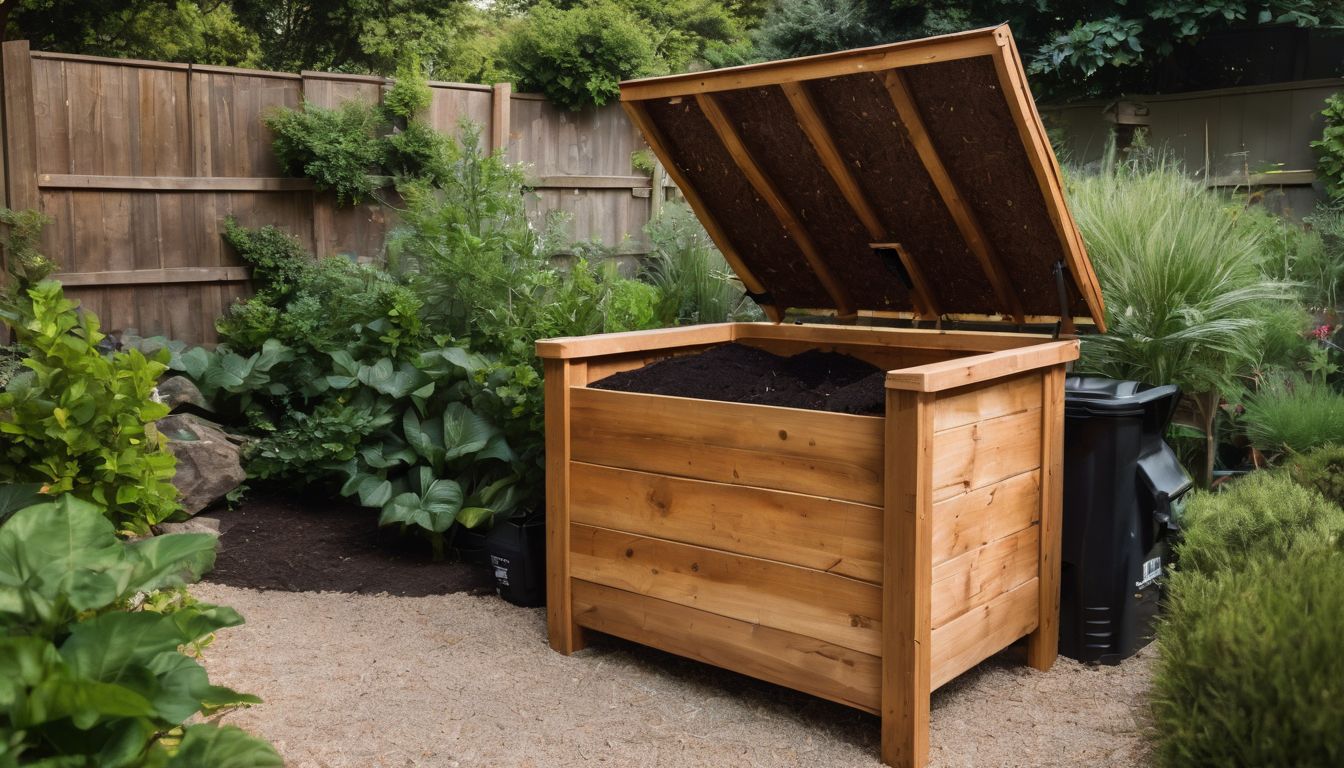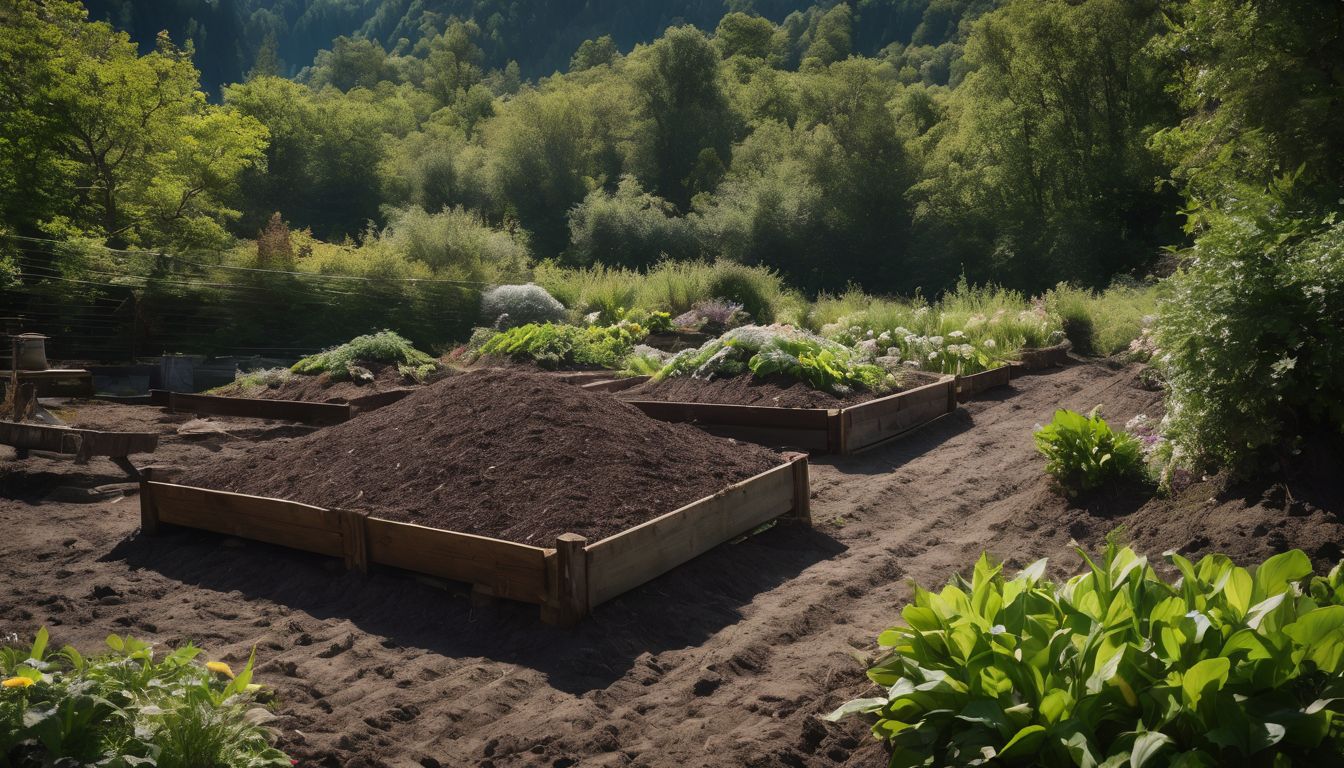Are you puzzled by your compost heap not breaking down as it should? A well-aerated compost can decompose organic waste more than 20 times faster. This post will guide you through the importance of aeration in creating rich, healthy compost.
Keep reading to unearth these earth-friendly secrets!
Key Takeaways
- Aerating your compost accelerates decomposition, transforming waste into nutrient-rich soil much faster by ensuring oxygen reaches crucial microorganisms.
- Regular turning of the compost, adding bulking agents like straw or wood chips, and using special tools such as compost aerators are practical ways to infuse air into your pile.
- The presence of oxygen through aeration not only speeds up the breaking down of organic materials but also diminishes the production of toxic substances in your compost.
- Introducing worms to your compost can significantly increase aeration and improve the breakdown process, leading to richer end-results for garden health.
- Properly managed aeration affects both temperature within the pile and microbial life; it promotes beneficial bacteria while maintaining an ideal heat range that supports fast yet thorough decomposition.
The Benefits of Aeration in Composting
Aerating compost improves its quality and promotes decomposition by allowing oxygen to reach the microorganisms. This results in a reduction of toxic materials and the production of biologically stable humus.
Improved compost quality
Aerating your compost pile can dramatically enhance the quality of the finished product. This is because oxygen is a key player in breaking down organic matter efficiently and thoroughly.
As microorganisms work their way through your compost, they need plenty of air to convert waste into nutrient-rich humus that benefits soil health immensely. A well-oxygenated compost will be homogenous, free from unpleasant odours, and packed full of the nutrients plants crave.
Ensuring good oxygen levels throughout your compost not only speeds up decomposition but also encourages aerobic bacteria to thrive. These beneficial microbes are essential for transforming kitchen scraps and garden waste into biologically stable material suitable for enriching gardens or agricultural land.
With improved airflow comes better temperature regulation, making it easier to maintain the ideal conditions necessary for optimal decomposing action and leading to next important aspect – promotion of decomposition.
Promotion of decomposition
Improvements in compost quality through aeration lead to the promotion of decomposition. The increased presence of oxygen encourages aerobic biochemical processes, enhancing organic matter decomposition and carbon dioxide production.
This creates biologically stable humus, advancing the breakdown of materials and promoting the release of nutrients into the environment.
Aerobic bacteria thrive on oxygen, facilitating nutrient cycling and supporting waste management efforts. As a result, a well-aerated composting system can effectively break down organic waste while maintaining a healthy balance of beneficial microorganisms essential for sustainable environmental practices.
Reduction of toxic materials
Promotion of decomposition is essential in reducing toxic materials within the compost. By enhancing microbial activity through aeration, harmful substances are broken down more efficiently, resulting in a safer and healthier compost product.
The increased oxygen levels promote the growth of aerobic bacteria which play a crucial role in breaking down toxic compounds into less harmful forms.
In turn, this supports environmentally friendly practices that align with conservation efforts and minimise negative impacts on the environment. Active participation in promoting these natural processes fosters a sustainable approach to waste management while contributing positively to our surroundings.
Aeration Methods
– Turning the pile regularly helps to introduce oxygen and break up clumps of compost, promoting aeration. Adding bulking agents like straw or wood chips can also improve air circulation within the compost pile.
Turning the pile
To create oxygen flow within the compost pile, turning the pile is an effective aeration method. This process also aids in mixing materials and breaking down larger pieces. By turning the pile, you can promote air circulation and distribute microorganisms evenly throughout the compost.
- Breaking up clumps: When you turn the pile, it helps to break up any clumps or compacted areas, allowing air to reach all parts of the compost.
- Aerating dense sections: Turning ensures that even denser parts of the compost receive oxygen, promoting decomposition and preventing anaerobic conditions.
- Distributing microorganisms: Regular turning helps spread beneficial microorganisms essential for decomposition throughout the entire compost heap.
- Assisting in moisture distribution: Turning helps distribute moisture evenly, preventing dry or waterlogged areas within the pile.
Adding bulking agents
To enhance aeration, consider adding bulking agents like straw or wood chips to the compost pile. Bulking agents create air pockets, improving airflow and oxygenation within the compost.
This helps in promoting aerobic decomposition and ensures that beneficial bacteria thrive, leading to better quality compost with improved structure.
Furthermore, bulking agents assist in maintaining proper moisture levels by preventing compacting of materials, thereby allowing for better air circulation throughout the compost pile.
Using a compost aerator
To improve air circulation in your compost pile, consider using a compost aerator. This tool helps to introduce oxygen into the center of the pile, promoting aerobic decomposition and reducing odors.
Compost aerators are easy to use and can be inserted directly into the pile to create air channels for better airflow.
When considering aeration in composting, it’s important to explore different methods for enhancing oxygen levels within the pile. Using a compost aerator is one effective way to achieve this goal without causing disruption or excessive manual labour.
Adding worms
Worms can be added to compost piles to enhance aeration and decomposition. This is achieved as worms burrow through the organic matter, creating passageways for air and moisture to circulate.
As they consume organic material, worms also produce nutrient-rich castings that further enrich the compost with beneficial microorganisms. Utilising worms in composting supports an eco-friendly approach by naturally aerating the pile while contributing to the overall health and fertility of the final product.
By introducing worms into your composting system, you can promote efficient breakdown of organic waste, improve soil structure and encourage a healthy environment for beneficial bacteria – all essential elements for successful composting outcomes.
Effects of Aeration on Temperature and Bacterial Community
Aeration in composting can affect temperature profiles within the pile, leading to changes in the bacterial community and promoting the decomposition process. Understanding these effects can help in managing aeration levels for optimal composting outcomes.
Temperature profiles
Adequate aeration significantly affects the temperature within a compost pile, fostering an environment conducive to efficient decomposition. Let’s explore how different aeration levels can impact the temperature profiles in composting.
table {
width: 100%;
border-collapse: collapse;
}
table, th, td {
border: 1px solid black;
}
th, td {
padding: 10px;
text-align: left;
}
th {
background-color: #f2f2f2;
}
Temperature Profiles Influenced by Aeration in Composting
| Aeration Level | Temperature Range | Impact on Composting Process |
|---|---|---|
| Low Aeration | Below 20°C | Slows down microbial activity leading to prolonged composting times. |
| Moderate Aeration | 20°C – 45°C | Supports a diverse microbial community, balancing decomposition and odor control. |
| High Aeration | Above 45°C | Speeds up decomposition but can lead to loss of nitrogen as ammonia and reduce moisture levels. |
By managing aeration, composters can cultivate ideal temperatures, which will expedite the composting process without compromising the quality of the end product.
Changes in bacterial community
Changes in the bacterial community occur when oxygen levels increase in the compost pile. This promotes the growth of beneficial aerobic bacteria, which accelerates decomposition and improves overall compost quality. Additionally, a well-aerated compost pile discourages the growth of anaerobic bacteria that produce foul odors and slow down the composting process. As a result, maintaining adequate oxygen levels through aeration techniques plays a crucial role in fostering a healthy bacterial community within the compost.
Moving on to “Aeration and Compost Maturity”, let’s explore how oxygenation influences the maturity of compost for optimal results.
Aeration and Compost Maturity
Aeration rate, C/N ratio, and moisture content all play a crucial role in determining the maturity of compost. Understanding these factors can help you create high-quality compost for your gardening or agricultural needs.
Aeration rate
To enhance the composting process, adjust the aeration rate by increasing oxygen levels. This promotes the growth of aerobic bacteria and speeds up decomposition. By controlling airflow, you can optimize moisture content and C/N ratio for efficient composting.
Adjusting the aeration rate influences the compost maturity and quality by promoting proper decomposition. Balancing air circulation within your compost pile ensures that organic matter breaks down efficiently without creating unpleasant odours.
C/N ratio
When considering the C/N ratio in composting, it’s important to maintain a balanced proportion of carbon and nitrogen. This ratio directly impacts the microbial activity responsible for breaking down organic matter into stable humus, promoting the creation of biologically stable compost.
A lower C/N ratio enhances decomposition, while a higher ratio may slow down or inhibit the process.
To ensure an optimal C/N ratio, environmentally conscious individuals should aim for a balance between “brown” materials high in carbon (such as dry leaves and straw) and “green” materials rich in nitrogen (like kitchen scraps and grass clippings).
Moisture content
Ensuring the appropriate moisture content is crucial in composting. The ideal moisture level of compost should range between 40-60%. Moisture aids in maintaining aerobic conditions, supporting microbial activities while preventing anaerobic conditions that could lead to unpleasant smells.
Too much moisture can hinder aeration, creating an environment for pathogens and unwanted microorganisms to thrive and slowing down the composting process.
Maintaining proper moisture levels also influences decomposition significantly. It is essential to regularly monitor and adjust the moisture content in your compost pile by adding water or dry materials as needed.
Conclusion
Aeration is crucial for composting. It boosts compost quality and aids in decomposition. Toxic materials are reduced through aeration. Turning the pile, adding bulking agents, and using aerators are effective methods.
Temperature profiles and bacterial communities are influenced by aeration. Compost maturity is improved with the right aeration rate and moisture content.
FAQs
1. Why is aeration important in composting?
Aeration is crucial because it helps supply oxygen to aerobic bacteria, which they need to break down organic matter into biologically stable humus effectively.
2. How does air circulation affect the composting process?
Good air circulation enhances decomposition by allowing oxygen to reach the microbes that are working hard to turn your waste into nutrient-rich compost.
3. Can seasonal effects impact how I aerate my compost?
Yes, seasonal changes can affect your compost; for instance, you might need to turn your pile more often in wet seasons to maintain proper airflow and prevent it from becoming too compacted and soggy.
4. What are some techniques used for adding air to my compost pile?
You can introduce more air into your compost through regular turning of the material or using forced aeration systems like aerated static pile composting or in-vessel methods for constant oxygenation.
5. Does better aeration really improve the quality of my compost?
Absolutely! Improving airflow with sufficient aeration techniques ensures faster degradation of organic matter and results in high-quality, healthier com post that’s great for your garden.





